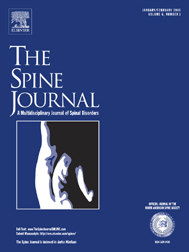
SPINE
Adjacent segment degeneration incidence uninfluenced by Total Disc Arthroplasty
This report has been verified
by one or more authors of the
original publication.
Spine Journal; 2010; 10; 1043-1048
93 patients, with mono or bi-level cervical disc symptomatic disease and upon failure of conservative treatment, were randomized to undergo total disc arthroplasty (TDA) or anterior cervical discectomy and fusion (ACDF). Primary Outcome Measures were Visual Analogue Score (VAS), Neck Disability Index and Radiographic Assessment were made at different time points until 48 months. Both the ACDF and TDA procedures were found to be equivalent for rendering pain relief in both mono and bi level disc disease and had equivalent risks for inducing adjacent segment degeneration. Interestingly, it was observed that patients with concurrent degenerative disc disease of the lumbar spine had greater likelihood of developing adjacent segment degeneration.
Unlock the full ACE Report
You have access to {0} free articles per month.Click below to unlock and view this {1}
Unlock NowCritical appraisals of the latest, high-impact randomized controlled trials and systematic reviews in orthopaedics
Access to OrthoEvidence podcast content, including collaborations with the Journal of Bone and Joint Surgery, interviews with internationally recognized surgeons, and roundtable discussions on orthopaedic news and topics
Subscription to The Pulse, a twice-weekly evidence-based newsletter designed to help you make better clinical decisions
Exclusive access to original content articles, including in-house systematic reviews, and articles on health research methods and hot orthopaedic topics
Or upgrade today and gain access to all OrthoEvidence content for just $1.99 per week.
Already have an account? Log in


Subscribe to "The Pulse"
Evidence-Based Orthopaedics direct to your inbox.
{0} of {1} free articles
Become an OrthoEvidence Premium Member. Expand your perspective with high-quality evidence.
Upgrade Now













































































